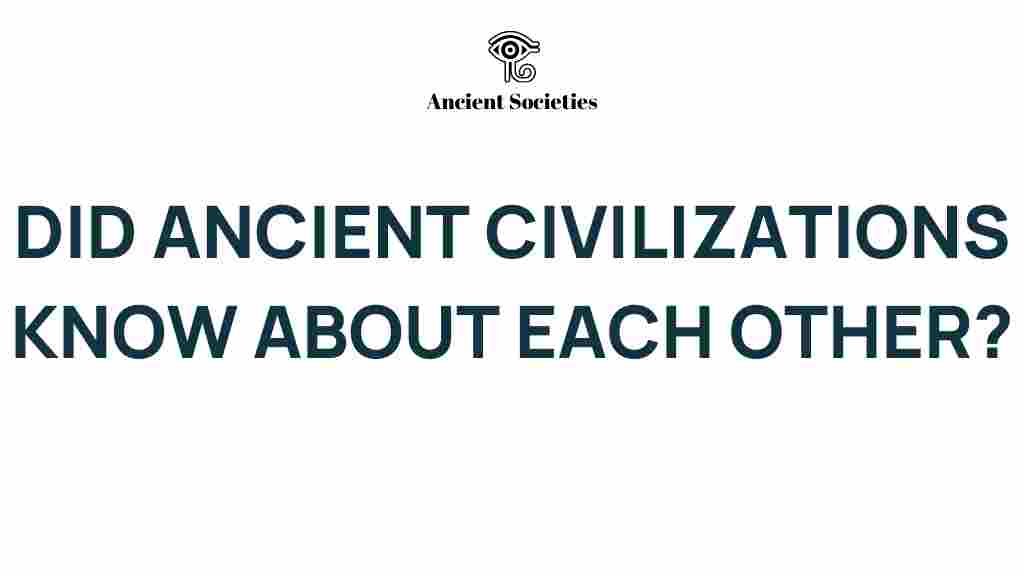Throughout history, ancient civilizations have risen and fallen, leaving behind a rich tapestry of cultural, scientific, and technological achievements. One of the most intriguing aspects of these ancient empires is the possibility of knowledge exchange and cross-cultural interactions. This article explores how these connections were facilitated through trade routes, the influence of cultural practices, and archaeological evidence that indicates a shared history among ancient civilizations.
The Importance of Trade Routes in Knowledge Exchange
Trade routes have been the lifeline of civilizations, acting as conduits for not only goods but also ideas and knowledge. The Silk Road, for example, was a network of trade routes that connected the East and West, allowing for a vibrant exchange of culture and knowledge.
- Silk Road: This ancient trade route connected China with the Mediterranean, facilitating the exchange of silk, spices, and ideas.
- Incense Route: Linking Arabia to the Mediterranean, it was crucial for the trade of incense, which also led to cultural exchanges.
- Trans-Saharan Trade Routes: These routes connected West Africa to the Mediterranean, promoting the exchange of gold, salt, and knowledge.
As merchants traveled these routes, they carried with them not just goods but also stories, technologies, and philosophies that enriched the civilizations they encountered.
Cultural Influence and Its Role in Knowledge Sharing
Cultures are not static; they evolve through interaction. The ancient civilizations of Mesopotamia, Egypt, the Indus Valley, and China influenced one another significantly over centuries.
- Mesopotamia: Often referred to as the cradle of civilization, it developed early writing systems like cuneiform that influenced neighboring cultures.
- Ancient Egypt: Its architectural prowess and religious beliefs impacted surrounding areas and later civilizations.
- Indus Valley Civilization: Known for its advanced urban planning and trade practices, it engaged in commerce with Mesopotamia.
These cultural exchanges laid the groundwork for future advancements and the spread of knowledge across regions.
Archaeological Evidence of Historical Connections
Archaeology plays a crucial role in uncovering the historical connections between ancient civilizations. Excavations and studies reveal artifacts that speak volumes about the interactions among these societies.
- Artifacts: Items such as pottery, tools, and jewelry often carry inscriptions or designs that reflect a blend of cultural influences.
- Trade Goods: The discovery of foreign goods in ancient sites indicates trade relationships, suggesting a network of knowledge exchange.
- Urban Layouts: Similarities in city planning and architecture can suggest shared ideas or direct influence from one civilization to another.
Such evidence helps to reconstruct the past and understand how ancient civilizations communicated and shared knowledge.
Understanding Cross-Cultural Interactions
Cross-cultural interactions were not limited to trade. Diplomacy, warfare, and migration also played significant roles in the exchange of knowledge and ideas.
- Diplomatic Missions: Envoys often traveled to establish alliances, sharing knowledge about governance and culture.
- Warfare: Conquests often led to the assimilation of knowledge from the conquered peoples.
- Migration: The movement of peoples facilitated the spread of technological innovations and cultural practices.
These interactions fostered a dynamic environment where ideas could flourish and evolve.
Ancient Communications: Tools and Techniques
Ancient civilizations developed various communication methods that facilitated knowledge exchange. From written language to oral traditions, these tools played a vital role in the dissemination of information.
- Writing Systems: The invention of writing allowed for the documentation of laws, trade agreements, and cultural narratives.
- Oral Traditions: Stories and knowledge passed down verbally played a crucial role in preserving cultural identity and sharing wisdom.
- Messengers: The use of messengers to carry information across distances helped maintain diplomatic relations and trade agreements.
Each of these communication methods contributed to the complexity and richness of ancient civilizations’ interactions.
Step-by-Step Process: How Knowledge Exchange Occurred
Understanding the process of knowledge exchange among ancient civilizations involves examining several key steps:
- Trade Initiation: Merchants and traders would start by establishing routes and networks for the exchange of goods.
- Interaction: Through trade, individuals from different cultures would meet and share ideas, technologies, and customs.
- Cultural Assimilation: As ideas were exchanged, they were often adapted and integrated into local practices, leading to new innovations.
- Documentation: Writing and art became mediums to record and spread new knowledge.
- Legacy: Over time, these exchanges contributed to the advancement of civilizations and the emergence of new cultural identities.
This process highlights the dynamic nature of ancient civilizations and their ability to learn from one another.
Troubleshooting Tips for Understanding Ancient Civilizations
When studying the connections between ancient civilizations, researchers may encounter several challenges. Here are some tips to navigate these hurdles:
- Interdisciplinary Approach: Collaborate with experts in archaeology, history, and anthropology to gain a well-rounded perspective.
- Contextual Analysis: Always consider the historical and cultural context of artifacts and texts to avoid misinterpretation.
- Stay Updated: Follow recent archaeological discoveries and research to keep informed about new findings that could reshape understanding.
By employing these strategies, scholars can better appreciate the complexities of knowledge exchange among ancient civilizations.
Conclusion: The Legacy of Knowledge Exchange
In conclusion, the exchange of knowledge among ancient civilizations was a multifaceted process shaped by trade routes, cultural influence, and historical connections. As empires rose and fell, the interactions they fostered left a lasting legacy that continues to inform our understanding of human history.
The evidence gathered from archaeology, written records, and cultural artifacts demonstrates that while ancient civilizations may have been geographically and culturally distinct, they were also interconnected in profound ways.
For further reading on the fascinating connections between ancient cultures, visit this resource. To explore the latest archaeological discoveries, check out this link.
Ultimately, unraveling these connections not only enriches our historical narratives but also reminds us of the shared journey of humanity through the ages.
This article is in the category Archaeology and created by AncientSocieties Team

1 thought on “Unraveling Connections: Did Ancient Civilizations Share Knowledge?”